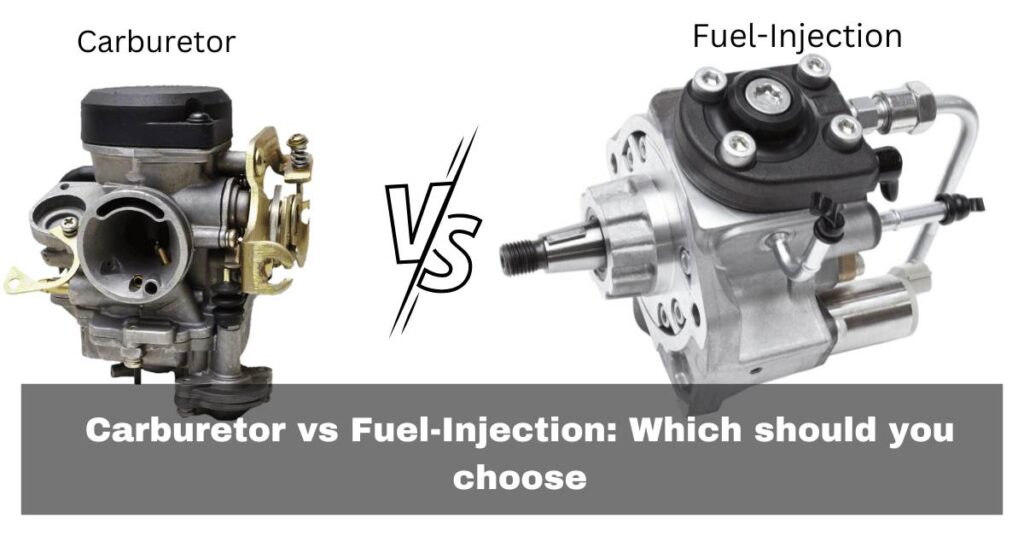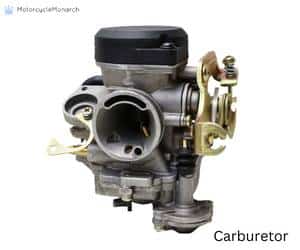
Fuel injection and carburetors are two different systems used to deliver fuel to the engine of a motorcycle. Both have their own set of advantages and disadvantages, and understanding the differences between the two can help you make a more informed decision when it comes to maintaining and upgrading your motorcycle.
In this article, we’ll take a closer look at fuel injection and carburetors, and explore the pros and cons of each system. We’ll also compare the performance, maintenance, and emissions of fuel injection and carburetors, and provide a personal recommendation on which system is best for your motorcycle.
Whether you’re a seasoned rider or a new enthusiast, this article will give you a better understanding of the inner workings of your motorcycle and help you make more informed decisions about its maintenance and upgrades. I will start this article by providing a short answer to the question.
So, What is the difference between Fuel Injection and Carburetor? Carburetor and fuel injection systems are different technologies used to deliver fuel to an internal combustion engine. Carburetor uses a mechanical process to mix fuel and air while a fuel injection system uses electronically controlled injectors for precise and efficient fuel delivery, resulting in better engine performance and emissions.
A carburetor is an older technology used to mix fuel and air for an internal combustion engine, while a fuel injection system is a more modern technology that delivers fuel directly into the engine using one or more injectors.
The carburetor uses a mechanical process to mix fuel and air, while the fuel injection system is electronically controlled, allowing for a more precise and efficient mixture.
Carburetors are less efficient and have a less precise fuel delivery method. It also provides less control over the fuel-to-air ratio, resulting in less optimal engine performance and emissions compared to fuel injection systems.
Now let’s understand each of these technologies in detail to have a better understanding of the same. We will start with the Carburetor system and talk about the fuel injection.
Carburetor

A carburetor is a device used in internal combustion engines to mix fuel and air before it enters the combustion chamber. It uses a mechanical process to mix the fuel and air, and its main function is to provide the correct ratio of fuel to air for the engine to run efficiently.
If we talk about its behind the science then Carburetor basically works on the principle of vaporization and Bernoulli’s principle.
Vaporization is the process of converting liquid fuel into a vapor form so that it can be mixed with air. Bernoulli’s principle states that as the velocity of a fluid (in this case, air) increases, its pressure decreases. The carburetor uses this principle to create the vacuum that draws fuel from the float chamber. Now, moving to the carburetor parts.
The carburetor has several main parts, including the throttle, which controls the amount of air that enters the engine, the float chamber, which maintains a constant fuel level, and the jet, which controls the flow of fuel.
When the accelerator is pressed, the throttle opens, allowing more air to enter the carburetor. As the air flows through the carburetor, it creates a vacuum that draws fuel from the float chamber into the jet. The jet then sprays the fuel into the incoming air stream, where it is mixed and delivered to the engine.
The carburetor also has a mechanism called the choke that enriches the fuel-air mixture when the engine is cold. This helps the engine to start when it’s cold.
The carburetor also has an idle speed screw that adjusts the fuel-air mixture when the throttle is closed. This controls the engine’s idle speed.
Carburetors are less efficient and have a less precise fuel delivery method. They also provide less control over the fuel-to-air ratio, resulting in less optimal engine performance and emissions compared to fuel injection systems.
In summary, Carburetor is an older technology that uses mechanical processes to mix fuel and air before it enters the combustion chamber. Its main function is to provide the correct ratio of fuel to air, but it is less efficient and precise than fuel injection systems and has less control over engine performance and emissions.
Here we have discussed the advantage and disadvantages of carburetors:-
| Advantages | Disadvantages |
| 1. Simple design and relatively easy to maintain. | 1. Carburetors can become clogged or dirty, causing engine issues. |
| 2. Can be less expensive than fuel injection systems | 2. Not as efficient as fuel injection systems |
| 3. Can handle a wide range of fuels. | 3. Not as precise in metering fuel as fuel injection systems. |
| 4. Can be used in a variety of applications, from small engines to large industrial engines. | 4. Can be affected by changes in altitude or temperature. |
| 5. Fewer electronic components mean fewer potential points of failure. | 5. May not meet emission standards in some jurisdictions. |
Fuel Injection

Nowadays, most people prefer fuel injection systems and the very reason is the precision method of delivering fuel to the engine which can be controlled easily with the help of a sensor. Let’s delve into the fuel injection system a little.
A fuel injection system is a technology used in internal combustion engines to deliver fuel into the combustion chamber. It is a more efficient and precise method of fuel delivery than the older carburetor systems.
In a fuel injection system, fuel is delivered to the engine through one or more injectors. The injectors are controlled by the engine control unit (ECU), which determines the amount of fuel to be delivered based on input from sensors that measure various engine parameters such as engine speed, coolant temperature, and intake air pressure.
There are two main types of fuel injection systems:
- Port fuel injection (PFI): Fuel is delivered to the intake ports of the engine, where it mixes with incoming air before entering the combustion chamber.
- Direct fuel injection (DFI): Fuel is delivered directly into the combustion chamber, where it mixes with compressed air.
Both types of fuel injection systems use a fuel pump to deliver fuel to the injectors under high pressure. The injectors are typically solenoid-operated valves that open and close to control the flow of fuel.
Fuel injection systems also include a variety of sensors and control components, such as an oxygen sensor, mass air flow sensor, and throttle position sensor, which work together with the ECU to control the fuel-to-air ratio and ensure optimal engine performance and emissions.
In summary, the Fuel injection system is a precision method of delivering fuel to the engine, that can be precisely controlled with the help of sensors and engine control units, which results in better fuel efficiency, power, and emission control.
Here we have discussed the advantage and disadvantages of the Fuel Injection System:-
| Advantages | Disadvantages |
| 1. More efficient fuel delivery, resulting in better fuel economy. | 1. Can be more complex and expensive to maintain and repair. |
| 2. More precise fuel metering for optimized engine performance. | 2. May require specialized diagnostic tools and equipment for repairs. |
| 3. Better emissions control, is often required to meet emissions standards. | 3. Can be more expensive to purchase than carbureted systems. |
| 5. Can provide real-time adjustments based on engine load, temperature, and other factors. | 4. More electronic components, meaning more potential points of failure. |
| 6. Can provide better cold start performance |
Difference between Carburetor and Fuel Injection System
Now, let’s understand the difference between Carburetor and Fuel Injection System. I have made a table with the difference between both technologies, so you will understand it fully.
| Feature | Carburetor System | Fuel Injection System |
| Fuel Delivery | Mixes fuel and air in a single unit before entering the engine, uses a venturi, throttle valve, and a jet to control the air-fuel ratio. | Delivers fuel directly into the engine with the help of injectors, and uses a computer-controlled system to adjust the air-fuel ratio. |
| Fuel Efficiency | Lower, due to a lack of precise control over the air-fuel ratio, leading to the wastage of fuel | Higher, as the computer-controlled system can adjust the air-fuel ratio as per the engine’s needs and operating conditions, leading to optimal fuel efficiency |
| Emissions | Higher, As the carburetor system can’t adjust the air-fuel ratio as per the engine’s needs, leading to higher emissions | Lower, As the fuel injection system can adjust the air-fuel ratio as per the engine’s needs, leading to lower emissions |
| Power and Performance | Reduced, as the carburetor can’t adjust the air-fuel ratio as per the engine’s needs | Improved, as the fuel injection can adjust the air-fuel ratio as per the engine’s needs, leading to optimal performance |
| Cold weather starting | Poor, as carburetors can have trouble starting in cold weather | Good, as the fuel injection system can provide the right amount of fuel for starting in cold weather |
| Simplicity | Simple design with fewer parts, mostly mechanical in nature | Complex design with more parts, mostly electronic in nature |
| Cost | Lower, as it is a simpler and older technology | Higher, as it is a newer and more advanced technology |
| Durability | High, as it has fewer moving parts and is less prone to wear and tear | Low, as it has more moving parts and is more prone to wear and tear |
| Repairability | Easy, as it has fewer parts and is simpler to diagnose and repair | Difficult, as it has more parts and is more complex to diagnose and repair |
| Maintenance | Low, as it requires less frequent maintenance | High, as it requires more frequent maintenance to ensure optimal performance |
Conclusion
So, we have discussed everything about the carburetors and fuel injection systems and the final question remains, What to choose? or Which is better for motorcycles?
The choice between a carburetor and a fuel injection system depends on various factors such as personal preference, budget, and intended use of the vehicle.
Both systems have their own unique advantages and disadvantages. The carburetor system is a simpler and older technology that is less expensive, durable, and easy to repair. However, it is less efficient in terms of fuel consumption and emissions control.
On the other hand, the fuel injection system is a newer and more advanced technology that is more efficient in terms of fuel consumption and emissions control, but it is more expensive, complex, and requires more maintenance.
So, I would be preferring a Fuel Injection motorcycle because it provides us the efficiency for fuel consumption and provides better performance. Also, nowadays most modern motorcycles are equipped with fuel injection technology so there is no need to do anything.
Thankyou for reading this article, I hope it helped you gaining the answer to the question you were looking for.

